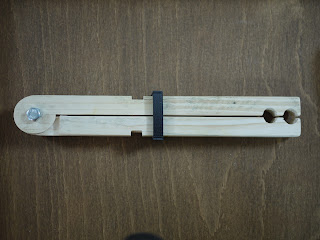Third Generation
Due to some selective forgetting, I had ignored some requirements for the second generation tongs. I think what I had done was to focus on the request that the next generation be slimmer and had forgotten that it should also be shorter. A few minutes with the bandsaw and the second generation tong became a third generation, and shorter:
Feedback from the second generation was that the smaller 'teeth' on the end:
weren't as good as the first generation:
So, I added teeth to the third generation that matched the second:
Another requirement that I had forgotten, but remembered once I had been reminded, was to have a clamp of some kind that could be used to hold things in the tongs without having to apply pressure for long periods of time. I had a think about this and was wondering about a hook arrangement, or levers of some kind. The clamp has to take into account different thicknesses of material to be clamped and allow tightening of some kind. Lever and hooks and so on were getting complicated. then i thought about doing this:
This is a rectangular 3D printed clamp that slides towards the end of the tongs as you clamp. As there is something in the tongs to clamp, the tong arms are at an angle so the clamp ring has a tightening action as you slide it up:
I then realised that you can use the clamp ring as a stop for the tong arms, so the leather stop can be removed. Excellent, the design is getting simpler.
Then, to stop the ring from dropping off the arms, I made a little home for it using a pair of recesses cut into the arms:
The ring was a bit big and probably wouldn't clamp thin items well, so I printed two more, successively smaller, rings and finally got one that will clamp down to a mall gap at the end of the tongs:
Because the ring was now smaller it was difficult to get it to leave home as the recesses had square sides. A bit of sanding and I had given one side of the recess a slope. This also allows clamping to be applied gradually, rather than the instant application needed when slipping the ring over the square edge.
This is the third generation in the closed position.
Actually, is this the third generation, or the fifth generation?





































